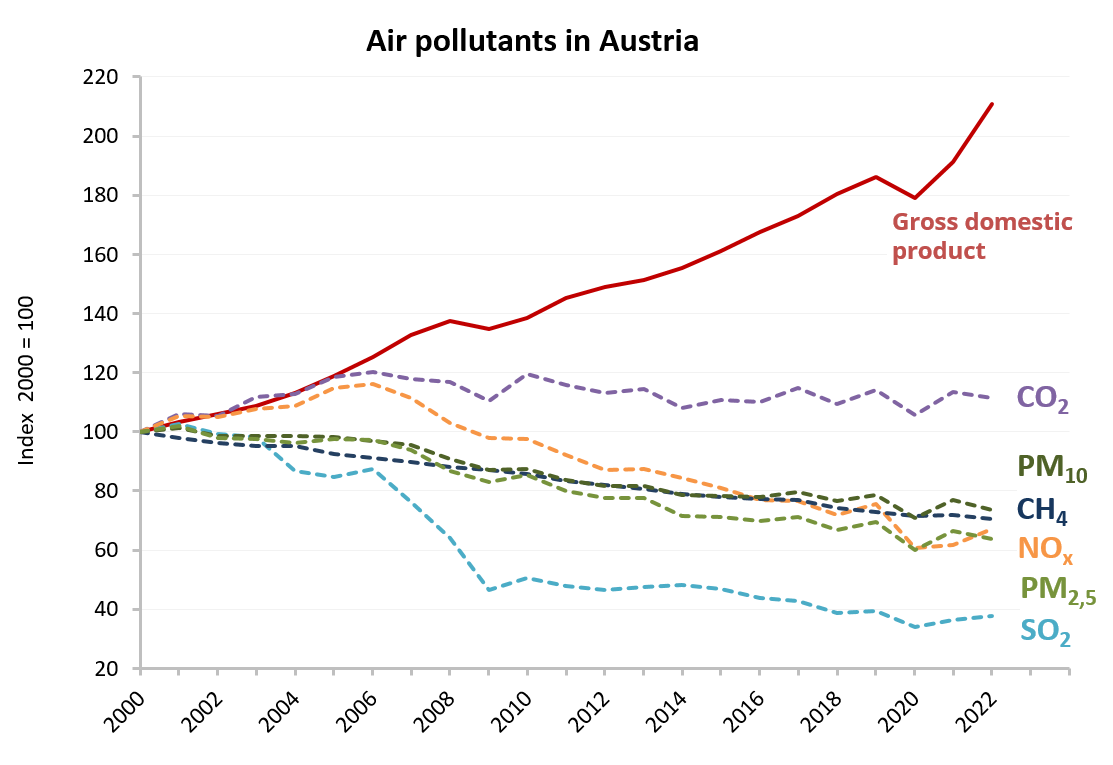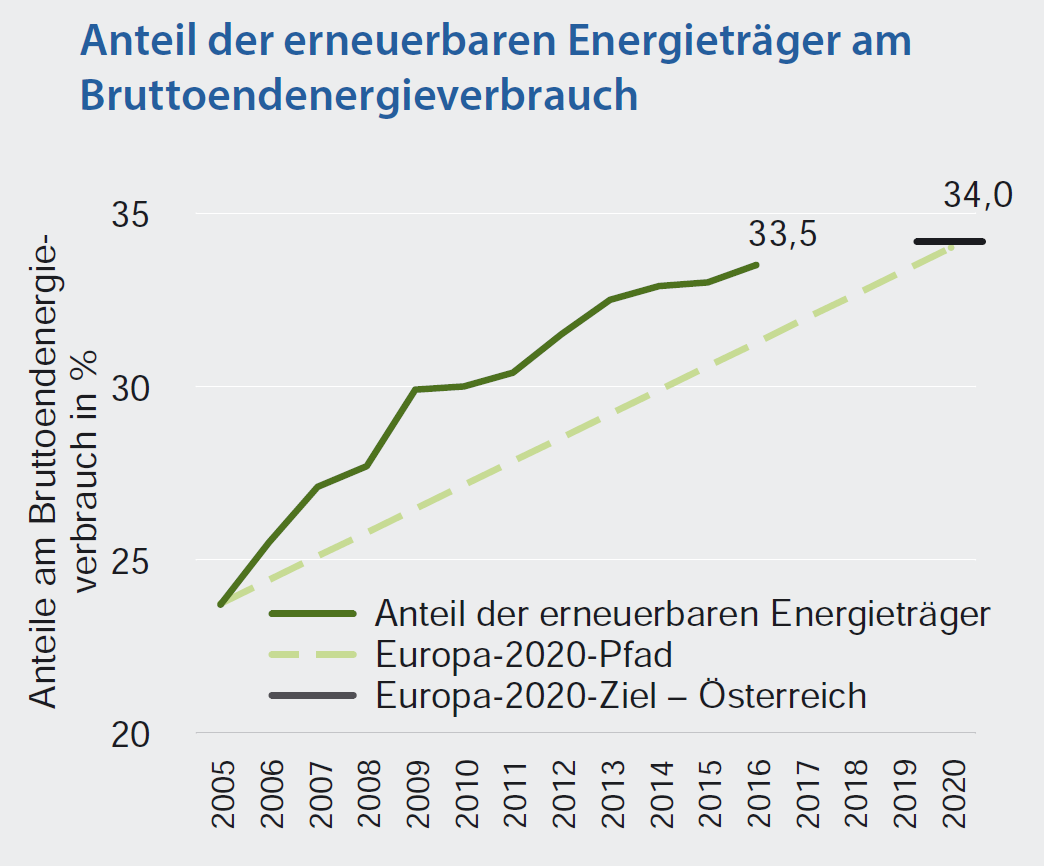Climate / Climate Change
The climate system has been influenced by humans since the beginning of industrialisation, especially as a result of greenhouse gas emissions which arise mainly from the use of resources and the burning of fossil energy sources but are also released during certain industrial processes. The level of emissions in the industrialised countries is generally higher than in the newly industrialised or developing countries. In terms of components, CO2 dominates total greenhouse gas emissions (both in Austria and at international level).

In December 2015, the international community adopted the Paris Climate Agreement, which came into force in November 2016. The agreement aims to help fight man-made climate change. It aims to keep the rise in the average global temperature well below 2°C above pre-industrial levels and that efforts be made to limit the rise in temperature to 1.5°C.
The goal of the Paris Agreement can only be achieved if the use of fossil fuels is largely phased out by the middle of the century.
In its latest assessment report (AR5), the Intergovernmental Panel on Climate Change came to the conclusion that the explosive increase in greenhouse gas emissions – largely due to population and economic growth – is the main reason for the rise in temperature since the mid-20th century. Overall, the anthropogenic influence on climate change is estimated at a probability of 95-99%.
The effects of climate change vary greatly from region to region and represent one of the greatest global challenges for the future. Certain regions/countries are particularly vulnerable to climate impacts - be it due to particularly strong regional climate changes (e.g. Mediterranean or Alpine regions), extreme vulnerability of the ecosystem ( example Sahel) or low adaptability of the national economy (example Bangladesh).
In Austria, the temperature increase in the past was more than twice as high as the global average. Climate models predict that Austria and the Alpine region will continue to warm up more than the global average in the future.
The rise in temperature will lead to an increase in drought and hot spells in the summer months, the risk of forest fires will increase, and there will be more heat-loving pests. Extreme weather events and, as a result, landslides, mudslides and rockfalls will occur more frequently.
Economic consequences of climate change affect, among other things, tourism, agriculture, forestry, energy management and the health care system.
Research in the area of climate change consists of the area of climate protection and the avoidance/reduction of greenhouse gas emissions, the area of climate impact research, which deals with the regional effects of climate change on people and the environment, and the area of developing adaptation strategies to climate change.
The economic consequences of climate change, unless suitable measures are taken to reduce greenhouse gas emissions, were estimated in the Stern Report published in 2006 to be 5 - 20% of global GDP. At the same time, the cost of measures aimed at stabilizing greenhouse gas emissions and limiting global warming to around 2°C would amount to one percent of global GDP – provided swift action is taken.
Current climate policy objectives in Austria
Since 2013 there has no longer been a national target for all greenhouse gas emissions, since a distinction is made between emissions within emissions trading (for which there is only one European target at -21% compared to 2005) and emissions outside of this system. For non-emissions trading sectors, national targets have been set for each member state as part of the European Effort Sharing Decision (ESD; Effort Sharing Decision). For Austria, an emission reduction of 16% by 2020 - based on the year 2015 - is planned. In addition, a legally binding target path from 2013 has been defined. The targets of the effort-sharing decision for Austria are anchored in the Climate Protection Act.
With the 2007 climate and energy package, the EU also set itself the legally binding target of increasing the share of renewable energy sources in gross final energy consumption in the EU to 20% by 2020. The target for Austria is 34%. In 2017, 32.6% was already achieved, in 2016 this value was already 33.5%.
Climate, emissions and environmental accounts
Climate-relevant data find their way into the physical accounts of environmental accounts via air emissions accounts. The air pollutants and greenhouse gases are shown: sulfur dioxide (SO2), nitrogen oxides (NOx), non-methane volatile organic compounds (NMVOC), methane (CH4), carbon monoxide (CO), carbon dioxide (CO2 - total, from fossil sources, from biogenic sources, from other sources), nitrous oxide (N2O), ammonia (NH3) and particulate matter (PM10/PM2.5).
The following graphic shows the development of the air pollutants CO2, SO2, NOx, CH4 as well as PM10 and PM2.5 in relation to the gross domestic product in the period from 2000 to 2022.
Data relevant to the climate is also recorded as part of the energy accounts and the material flow accounts. In addition to the consumption of fossil fuels in both accounts, the energy accounts also include the production and consumption of renewable energy sources. The share of renewable energy sources in gross final energy consumption is important with regard to monitoring the target path and the achievement of targets for the 2007 Climate and Energy Pact.
In the Austrian Integrated NAMEA, economic indicators such as production value, gross value added and employment in full-time equivalents are compared with environmental, physical indicators that contain climate-relevant information. The primary focus here is on the material use, energy use and air emissions already mentioned, but also on hazardous and non-hazardous waste. Environment-related expenses such as eco-taxes and environmental protection expenses (for air pollution control and climate protection) are also relevant.
On the one hand, the NAMEA enables a representation of the overall economic development and the associated environmental or climate-relevant effects and, on the other hand, the results of the NAMEA can also be broken down to the level of the economic sectors and private households, thereby enabling a more precise analysis of climate-relevant developments due to social action.
Environment Agency Austria: Klima (Klimaschutz, Klimawandel & Klimawandelanpassung)
Environment Agency Austria: Klimaschutzbericht 2018 (German)
Federal Ministry Economy, Energy and Tourism of Austria: Erneuerbare Energie (German)
Broschüre „Erneuerbare Energien 2020 - Entwicklung in Österreich“
Intergovernmental Panel on Climate Change (IPCC)


